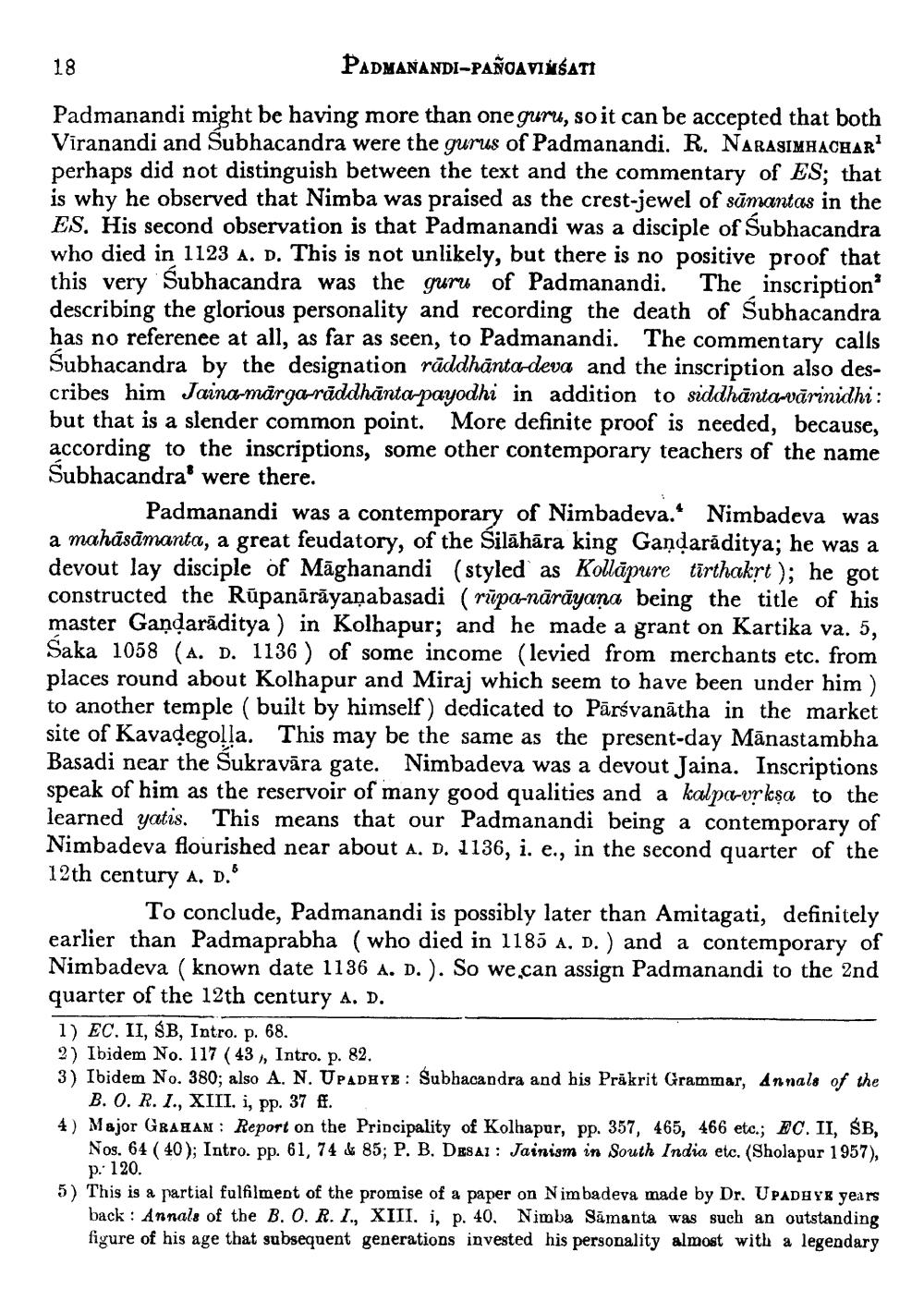________________
18
PADMANANDI-PAÑOAVIMSATI
Padmanandi might be having more than one guru, so it can be accepted that both Viranandi and Subhacandra were the gurus of Padmanandi. R. NARASIMHACHAR' perhaps did not distinguish between the text and the commentary of ES; that is why he observed that Nimba was praised as the crest-jewel of sūmantas in the ES, His second observation is that Padmanandi was a disciple of Subhacandra who died in 1123 A. D. This is not unlikely, but there is no positive proof that this very Subhacandra was the guru of Padmanandi. The inscription describing the glorious personality and recording the death of Subhacandra has no reference at all, as far as seen, to Padmanandi. The commentary calls Subhacandra by the designation rāddhānta deva and the inscription also describes him Jaino-margarāddhänta payodhi in addition to siddhānta-vārinidhi: but that is a slender common point. More definite proof is needed, because, according to the inscriptions, some other contemporary teachers of the name Subhacandra' were there.
Padmanandi was a contemporary of Nimbadeva. Nimbadeva was a mahāsāmanta, a great feudatory, of the Silāhāra king Gandarāditya; he was a devout lay disciple of Māghanandi (styled as Kollāpure tīrthakrt); he got constructed the Rūpanārāyaṇabasadi (rūpa-nārāyana being the title of his master Gaņdarāditya) in Kolhapur; and he made a grant on Kartika va. 5, Saka 1058 (A. D. 1136 ) of some income (levied from merchants etc. from places round about Kolhapur and Miraj which seem to have been under him ) to another temple ( built by himself) dedicated to Pārsvanātha in the market site of Kavadegolla. This may be the same as the present-day Mānastambha Basadi near the Sukravāra gate. Nimbadeva was a devout Jaina. Inscriptions speak of him as the reservoir of many good qualities and a kalpa-vrkșa to the learned yatis. This means that our Padmanandi being a contemporary of Nimbadeva flourished near about A. D. 1136, i. e., in the second quarter of the 12th century A. D.
To conclude, Padmanandi is possibly later than Amitagati, definitely earlier than Padmaprabha ( who died in 1185 A, D.) and a contemporary of Nimbadeva ( known date 1136 A. D.). So we.can assign Padmanandi to the 2nd quarter of the 12th century A. D. 1) EC. II, SB, Intro. p. 68. 2) Ibidem No. 117 ( 43 ), Intro. p. 82. 3) Ibidem No. 380; also A. N. UPADHYE : Subhacandra and his Präkrit Grammar, Annals of the
B. 0. R. I., XIII. i, pp. 37 ff. 4) Major Geanan: Report on the Principality of Kolhapur, pp. 357, 465, 466 etc.; EC. II, SB,
Nos. 64 ( 40 ); Intro. pp. 61, 74 & 85; P. B. DESAI: Jainism in South India etc. (Sholapur 1957),
p: 120. 5) This is a partial fulfilment of the promise of a paper on N im badeva made by Dr. UPADHY8 years
back: Annals of the B. O. R. I., XIII. i, p. 40. Nimba Samanta was such an outstanding figure of his age that subsequent generations invested his personality almost with a legendary
gure of his age that 5:0. R. 1., XIII. i. a paper on Nimbader




